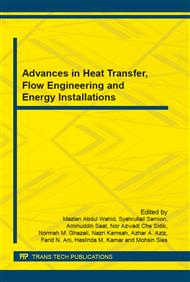[1]
W. Han, H. Jin and W. Xu, A novel combined cycle with synthetic utilization of coal and natural gas, Energy 32 (2007) 1334-1342.
DOI: 10.1016/j.energy.2006.10.012
Google Scholar
[2]
E. Ruiz, J. M. Sanchez, M. Marono and J. Otero, CO2capture from PCC power plants using solid sorbents: Bench scale study on synthetic gas, Fuel 114 (2013) 143-152.
DOI: 10.1016/j.fuel.2012.06.111
Google Scholar
[3]
K. Goransson, U. Soderlind, J. He and W. Zhang, Review of syngas production via biomass DFBG, Renewable and Sustainable Energy Review 15 (2011) 482-492.
DOI: 10.1016/j.rser.2010.09.032
Google Scholar
[4]
Y. S. Kim, J.J. Lee, T.S. Kim, J. and L. Sohn, Effect of syngas type on the operation and performance of a gas turbine in integrated gasification combines cycle, Energy Conversion and Management 52 (2011) 2262-2271.
DOI: 10.1016/j.enconman.2011.01.009
Google Scholar
[5]
R. Chacartegui, D. Sanchez, J.M. Munoz de Escalona, A. Munoz and T. Sanchez, Gas and steam combined cycles for low calorific syngas fuels utilisation, Applied Energy 101 (2013) 81-92.
DOI: 10.1016/j.apenergy.2012.02.041
Google Scholar
[6]
F. Delattin, G. D. Lorenzo, S. Rizzo, S. Bram and J. D. Ruyck, Combustion of syngas in a pressurized microturbine-like combustor: experimental results, Applied Energy 87(2010) 1441-1452.
DOI: 10.1016/j.apenergy.2009.08.046
Google Scholar
[7]
M.C. Lee, S. B. Seo, J.H. Chung, S. M. Kim, Y. J. Joo and D. H. Ahn, Gas turbine combustion performance test of hydrogen and carbon monoxide synthetic gas, Fuel 89 (2010) 1485-1491.
DOI: 10.1016/j.fuel.2009.10.004
Google Scholar
[8]
M.C. Lee, S. B. Seo, J. Yoon, M. Kim, Y. Yoon, Experimental study on the effect of N2, CO2, and steam dilution on the combustion performance of H2 and CO synthetic gas in an industrial gas turbine, Fuel 102 (2012) 431-438.
DOI: 10.1016/j.fuel.2012.05.028
Google Scholar
[9]
M. C. Cameretti, R. Tuccillo and R. Piazzessi, Study of an exhaust gas recirculation equipped micro gas turbine supplied with bio-fuel, Applied Thermal Engineering 59 (2013) 162-173.
DOI: 10.1016/j.applthermaleng.2013.04.029
Google Scholar
[10]
H. Hasini, N. H. Shuaib and W.A. F Wan Abdullah, CFD analysis of temperature distribution in can-type combustor firing synthetic gas, Applied Mechanic and Materials 393 (2013) 741-746.
DOI: 10.4028/www.scientific.net/amm.393.741
Google Scholar
[11]
M.C. Lee, J. Yoon, S. Joo, J. Kim, J. Hwang and Y. Yoon, Investigation into the cause of high multi-mode combustion instability of H2/CO/Ch4 syngas in a partially premixed gas turbine model combustor, Proceeding of Combustion Institute (2014).
DOI: 10.1016/j.proci.2014.07.013
Google Scholar
[12]
S. Park, U. Kim, M. Lee, S. Kim and D. Cha, The effect and characteristics of hydrogen in SNG on gas turbine combustion using a diffusion type combustor, International Journal of Hydrogen Energy 38 (2013) 12847-12855.
DOI: 10.1016/j.ijhydene.2013.07.063
Google Scholar
[13]
P. Gobbato, M. Masi, A. Toffolo and A. Lazzaretto, Numerical simulation of a hydrogen fuelled gas turbine combustor, International Journal of Hydrogen Energy 36 (2011) 7993-8002.
DOI: 10.1016/j.ijhydene.2011.01.045
Google Scholar
[14]
H. F. Abbas and W.M.A. Wan Daud, Hydrogen production by methane decomposition: a review, International Journal of Hydrogen Energy 35 (2010) 1160-1190.
DOI: 10.1016/j.ijhydene.2009.11.036
Google Scholar
[15]
N. E. L. Haugen, C. Brunhuber and M. Bysveen, Hydrogen fuel supply system and re-heat gas turbine combustion, Energy Procedia 23 (2012) 151-160.
DOI: 10.1016/j.egypro.2012.06.049
Google Scholar


